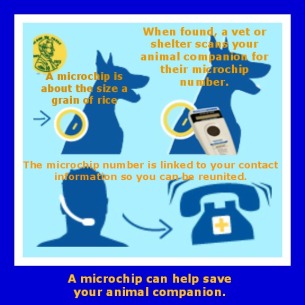Its National Pet I.D. Week – Are your animal companions protected?
Each year, 10 million animals are lost. One in three family animal companions will become lost in their lifetime. I have heard many times why many people believe that pet I.D. devices aren’t necessary: “I have an indoor cat,” or “My dog never leaves the yard,” or “We always have them on a leash when we leave the house,” or “They never go outside,” or “We don’t need pet IDs.”
But unexpected things can happen. Natural disasters like tornados and hurricanes can cause unexpected separations, and pet theft is on the rise. More common issues include a cat that slips through the front door, or the dog clears that fence with a jump that you thought was impossible, or the bird that flies outside when a guest comes over, or that somehow escapes when the pet sitter comes over. The opportunities for your animal companion to escape or become separated from you are countless. Even indoor-only animals, assumed to be safely confined and whose guardians have provided them with the most sophisticated gates and fences to securely play outdoors, are at risk of going missing. If an animal is determined to get away, then I promise you, they can and will find ways to do so.
According to the ASPCA, each year an estimated 5 to 7 million dogs and cats arrive at shelters. Only half of those numbers are strays. Only 15 to 20 percent of dogs and 2 percent of cats are reunited with their family. The rest, unfortunately, do not have a happy ending.
There are very easy measures that you can take to make sure there’s a way to identify your animal companion should he or she become inadvertently separated from you:
- Microchip – A small inert device that has an individualized code that is unique to your animal companion. It’s about the size a grain of rice. They are placed si
 mply and relatively painlessly under their skin within minutes at the vet’s office. When a lost animal has been found, veterinary offices and animal shelters have a scanner that checks for these chips under the skin and enables an animal clinic or veterinary hospital to contact you. If your animal companion has been injured while lost, the ability to contact you that the chip provides could be urgent – and life saving when it comes to needing your approval to provide necessary medical care or talk about treatment options. According to a research study, the return rate for lost animals with microchips was 20 times higher for cats and 2.5 times higher for dogs compared to lost animals without a microchip identification device. If your animal companion already has a microchip, have your vet scan it routinely to make sure it’s still functioning. Register your information through the microchip company’s website and make sure they have updated contact information. A microchip can help save your animal companion. Learn more about how you can protect your animal companion with a microchip here.
mply and relatively painlessly under their skin within minutes at the vet’s office. When a lost animal has been found, veterinary offices and animal shelters have a scanner that checks for these chips under the skin and enables an animal clinic or veterinary hospital to contact you. If your animal companion has been injured while lost, the ability to contact you that the chip provides could be urgent – and life saving when it comes to needing your approval to provide necessary medical care or talk about treatment options. According to a research study, the return rate for lost animals with microchips was 20 times higher for cats and 2.5 times higher for dogs compared to lost animals without a microchip identification device. If your animal companion already has a microchip, have your vet scan it routinely to make sure it’s still functioning. Register your information through the microchip company’s website and make sure they have updated contact information. A microchip can help save your animal companion. Learn more about how you can protect your animal companion with a microchip here.
- Update their identification information – Key information like their name, your contact information, and any medical conditions should be included on their ID tags. They should be wearing their ID tags AT ALL TIMES. Rabies tags are another way for people to locate you in the event that your animal companion becomes separated from you. If you move, don’t forget to update their tags with your new contact information.
- Get a good photograph of each animal companion – Make sure you have a good photo to post on social media sites and for lost pet posters. They are vital in people helping to identify lost animals.
- Meet and Greet – Introduce your animal companion to your neighbors or people that live around you. Have an official meet and greet or show them a picture of your animal companion. This will help your neighbors to know what your bird, pig, ferret, rabbit, cat, rat or dog, etc. looks like in the event that he or she escapes. If they are seen, your neighbors will be familiar with them and know that they aren’t supposed to be running amuck!
- Know who to call – Create a list in advance of your local animal controls agencies, rescues, shelters, and nearby veterinary offices to alert them if your animal companion becomes lost.
- The Tagg™ pet tracking system – A GPS tracking system that allows you to track your animal companion’s location at any time from your computer or mobile device. The lightweight tracker attaches to your companion animal’s existing collar, and is designed to be worn at all times, even while swimming. It is rather bulky, but unlike a microchip, which won’t alert you if your animal companion is lost, the Tagg sends you a text and email when your animal companion gets out so you can find him or her immediately. Watch this video to see how Tagg works. They even have a gps tracker for cats.
Since it’s National Pet I.D. week, there is no better time to get all of this in order. Now is the time to ensure that your animal companions are protected if they happen to escape or are stolen. Animals escape when you least expect it, so it’s necessary to be prepared. Being a responsible, conscious companion means you must take the precautions to ensure their safety and quick recovery in the event they are separated from you. Why take the risk?
Prevention starts now, and it starts with you!






This is a wonderful & informative article on a very important & low cost way to protect your pet. Many horse owners are microchip ping their horses as well.
LikeLike
Thank you, Heather!
And thank you for mentioning horses! Horse microchiping is a must as well. So many can get loose or stolen. It’s the safest way to ensure they’re ID’d.
LikeLike
Pingback: The Fourth of July Doesn’t Have to Be “Feline Fright Night”! | Conscious Companion
Pingback: Stray Cat Strut | Conscious Companion
Pingback: Be Kind To Animals E V E R Y Week | Conscious Companion
Many eyes make it much easier to find your pet. That is why it is a good idea to have a good photograph of your pet to post on social media. If you could give a quality picture to your local pound, it could be helpful to them.
LikeLiked by 1 person